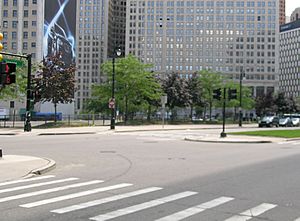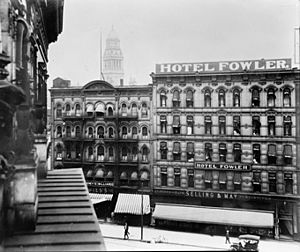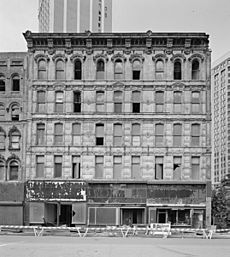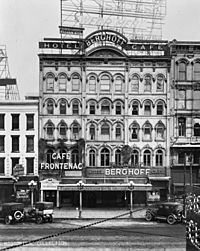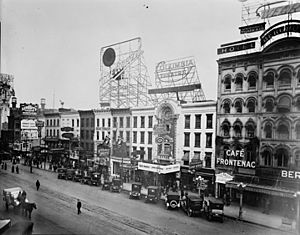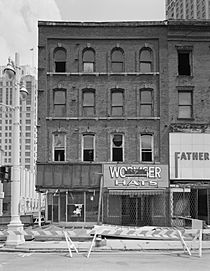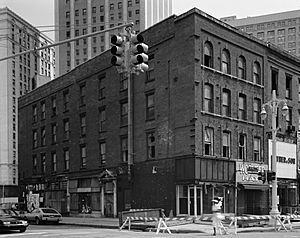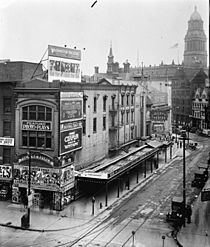Monroe Avenue Commercial Buildings facts for kids
|
Monroe Avenue Commercial Buildings
|
|
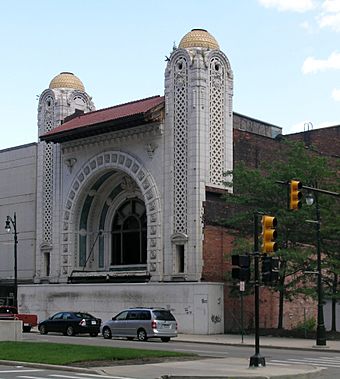
The National Theatre (1911-2024) at 118 Monroe Ave., taken in 2008; it had been the oldest surviving theatre in Detroit, a part of the city's original theatre district from the late 1800s.
|
|
| Location | Detroit, Michigan, U.S. |
|---|---|
| Architect | Albert Kahn, Mortimer L. Smith, Sheldon Smith, Frank G. Baxter and Henry A. O'Dell |
| Architectural style | Late Victorian |
| NRHP reference No. | 75000968 |
Quick facts for kids Significant dates |
|
| Added to NRHP | February 13, 1975 |
The Monroe Avenue Commercial Buildings, also known as the Monroe Block, was a special group of old buildings in Detroit, Michigan. They were located on Monroe Avenue, near Woodward Avenue and Campus Martius. This area was recognized as a Michigan State Historic Site in 1974. It was also added to the National Register of Historic Places in 1975.
Most of the thirteen buildings were built between 1852 and 1911. They were two to five stories tall. The National Theatre, built in 1911, was the oldest surviving theatre in Detroit. It was part of the city's first theatre area from the late 1800s. Sadly, the National Theatre was the only building left from this historic group. It was torn down in 2024.
A Look Back: History of Monroe Avenue
The first buildings on Monroe Avenue were built in the Victorian commercial style. Architects like Sheldon and Mortimer Smith designed them in the mid-to-late 1800s. One important group of buildings was called the Johnson Block. It was one of the last places in Detroit with buildings from before the American Civil War.
Over the years, many different businesses called these buildings home. At first, there were grocery stores, candy shops, and saloons. In the early 1900s, many new people moved to Detroit from Europe. They opened jewelry shops, pawn shops, and tailor shops in the area.
Monroe Avenue: Detroit's Entertainment Hub
Around the same time, the Campus Martius area became the main entertainment spot in Detroit. The Detroit Opera House was a big attraction nearby. In 1901, the Wonderland vaudeville theatre moved close by.
The early 1900s was also when movies became popular. Detroit's movie history began right here on Monroe Avenue! The very first movie theater in Detroit was the Casino. It opened on Monroe Avenue in 1906. It was opened by a man named John H. Kunsky. Some say it was the second movie theater in the whole world! Kunsky later built a huge movie theater business.
Later in 1906, Detroit's second movie theater, the Bijou, opened just two doors down from the Casino. These were the first of many theaters on Monroe Avenue. Three new movie theater buildings were built in the next five years:
- The Star (1907), designed by Frank G. Baxter and Henry A. O'Dell.
- The Columbia (1911), designed by famous theater architect C. Howard Crane.
- The National Theater (1911), the only theater designed by Albert Kahn.
Other theaters also opened nearby, making Monroe Avenue a lively place for entertainment.
However, by the 1920s, the main movie area in Detroit moved to Grand Circus Park. Monroe Avenue became less important for big movie premieres.
Most of the old buildings on Monroe Avenue were torn down in 1990. Only the National Theater remained for many years. It reminded people of the area's rich history.
What the Buildings Looked Like
The buildings that once stood here showed a mix of old styles. Some were built before the American Civil War, and others after. There were also several movie theaters from the early 1900s.
| Pictures of the Monroe Block
|
|---|
The Williams Blocks
Two important buildings were known as the Williams Blocks. They were built by John Constantine Williams, whose family was very wealthy in Detroit.
Second Williams Block (16-30 Monroe Avenue)
This building was constructed in 1872–73. It was designed by Mortimer L. Smith. It started as an office building with shops on the first floor. Later, it became the Kirkwood Hotel. In 1909, much of the building was changed into the Family Theater, which showed movies starting in 1914. The Family Theater was renamed the Follies in 1967. Sadly, it burned down in 1973. The rest of the building was torn down in 1990.
The Second Williams Block was five stories tall. It was made of brick with sandstone on the front. It had a flat roof and decorative carvings.
First Williams Block (32-42 Monroe Avenue)
The First Williams Block was built earlier, in 1859. Sheldon Smith was the architect. It was also an office building with shops. In the late 1880s, it became a hotel called the Stanwix, then Gies' European hotel. It changed names several times, including the Berghoff and the Frontenac Hotel. The hotel stayed open until 1960. This building was also torn down in 1990.
This block was five stories tall and made of red brick. It had decorative brickwork and cast iron details.
Columbia Theater (50 Monroe)
The Columbia Theater was built in 1911 for John H. Kunsky. It was designed by C. Howard Crane and could seat over 1000 people. It even had its own pipe organ and orchestra! The Columbia Theater closed in 1956 and has since been torn down.
The Johnson Block
Hiram R. Johnson bought land on Monroe Avenue in 1852. He built a group of commercial buildings known as the "Johnson Block." These buildings were located at 52–54, 58, 62, 66–68, and 70–72 Monroe Avenue.
All five buildings were made of brick and were four stories tall. They had a similar design with rectangular windows. They were torn down in 1990.
Two of these buildings were very important for the start of movie theaters in Detroit:
- In 1905, William H Klatt opened a "cent-odeon" (like a nickelodeon) at 62 Monroe.
- The next year, John H. Kunsky opened Detroit's first true movie house, the Casino Theater, at 70-72 Monroe.
- Klatt quickly turned his place into Detroit's second movie house, "The Bijou." It stayed a movie house for 70 years!
Other buildings in the Johnson Block had small shops and restaurants. They housed everything from saloons and jewelry stores to umbrella factories and bookstores over the years.
| More Johnson Block Images
|
|---|
74-78 Monroe Avenue
This building was built around 1852. It faced both Monroe Avenue and Farmer Street. Over time, it housed restaurants, tailors, cigar stores, and shoe stores. A barber shop was there from 1915 until the late 1970s! A dentist's office was on the second floor for many years too. This building was also torn down in 1990.
It was a four-story building made of red brick. It had tall, narrow windows with decorative brickwork.
Star (Royal) Theater (100-102 Monroe Avenue)
This building was built in 1907 as the Star Theater. Frank G. Baxter and Henry A. O'Dell designed it. It only operated as the Star for a year. In 1908, it became the Theatre Royale, then the Royal Theater in 1912. The Royal closed in 1922. After that, it housed various shops like cigar stores, jewelers, and barber shops. It was torn down in 1990.
The Star was a four-story building made of red and yellow brick. It had a large arched window on the front and decorative features.
104-106 Monroe Avenue
This building was built around 1900. It first had a saloon, then a tea store. For most of its life, it housed lunch rooms and clothing or shoe stores. It was empty by the 1970s and torn down in 1990.
It was a four-story building. Its front was changed in 1923, adding white brick and large glass windows.
National Theatre (118 Monroe Avenue)
The National Theater, built in 1911, was designed by Albert Kahn. It was the only known theater he designed. It was also the oldest surviving theater from Detroit's original theater district. It started as a movie theater. But in the 1920s, bigger movie houses opened, so it became a vaudeville theater. It then became a burlesque theater until it closed in the 1970s.
The front of the National Theatre was very striking. It had a huge arch with two towers. It was covered in white and blue terra cotta tiles. Hundreds of lightbulbs were built into the front, making it shine when lit up. The theater was a great example of Modernistic design. It featured beautiful terra cotta towers, arched art glass windows, and colorful Pewabic tiles.
The National Theatre was torn down in January 2024. Its historic front was carefully taken apart to be used again in a new building. However, the rest of this unique theater was destroyed.
|
See also
 In Spanish: Edificios comerciales de Monroe Avenue para niños
In Spanish: Edificios comerciales de Monroe Avenue para niños


